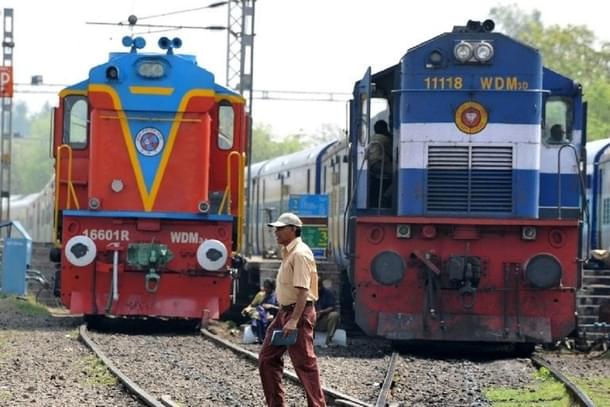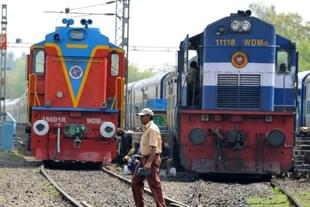Infrastructure
How Indian Railways Is Pushing Ahead With Modernisation
Arun Kumar Das
Dec 18, 2022, 09:08 AM | Updated 09:08 AM IST
Save & read from anywhere!
Bookmark stories for easy access on any device or the Swarajya app.


According to the Railways, technology development for the modernisation of the national transporter is a continuous process, and a series of initiatives is being taken up in this regard.
In the track segment, which is crucial for train operations, the Railways has introduced mechanised track maintenance using technologically advanced machines like high-output tamping and stabilising machines.
The machines have enabled the Railways to increase the output of track maintenance manifold as compared to manual track maintenance.
The inspection of tracks has also been modernised by using the technologically advanced track recording car, which is faster and more reliable. It has the additional feature of video recording of track components.
The life of rails has been enhanced with the introduction of rail grinding machines. The newly procured high-output rail grinders and specialty grinders are in the process of introduction for fast and complete rail grinding.
The modern track structure, consisting of the pre-stressed concrete sleeper and steel channel sleepers on girder bridges, is used while carrying out primary track renewals.
Ultrasonic testing of rails is being carried out to detect flaws like fractures on the track.
For the strengthening of bridges, the Railways has developed the bridge management system (BMS), a web-based information technology (IT) application, to facilitate 24x7 availability of information, such as bridge drawings or design details, inspection details, photographs, and videos, for a meaningful analysis and assessment of progressive deterioration and capacity to carry increased loads.
New and modern technologies have been introduced to upgrade inspection techniques for bridges, such as continuous water level measurement and monitoring system, inspection of bridges using drones, and 3D scanning of riverbeds.
The Railways has installed a continuous water level monitoring system at 305 bridges across the country. It provides SMS alerts (text messages) to railway officials every day (evening or morning).
For the rolling stock, advanced or improved technologies like the online monitoring of rolling stock system (OMRS) and wheel impact load detector (WILD) have been adopted for predictive maintenance of the rolling stock.
Presently, 25 OMRS systems and 20 WILD systems have been installed and are operational over the railway network.
Radio-frequency identification (RFID) tags are being fit on to the rolling stock to automatically track and trace the rolling asset moving over the rail network.
In addition, other technological systems like the global positioning system (GPS) in wagons, the hot box detector (BBD), and the machine vision inspection system (MVIS) are also under development for implementation.
For the EMU/MEMU, a system of conversion of end-on-generation trains into head-on-generation trains has been introduced to reduce noise and air pollution at stations and in trains.
There's also the introduction of IGBT-based three-phase technology in EMU/MEMUs, Kolkata Metro, and Vande Bharat trains.
The Vande Bharat Express has modern features such as automatic doors with retractable footsteps, onboard Wi-Fi and infotainment, GPS-based passenger information system, roller blinds, and diffused LED lighting.
EMU/MEMUs, Kolkata Metro, and Vande Bharat trains' rakes are manufactured with stainless steel car body. This will enhance the codal life of coaches.
A GPS-based passenger announcement-cum-passenger information system (PAPIS) has been installed in EMU and Kolkata Metro.
The passenger information system informs passengers about the next approaching station through an audio announcement via speakers as well as through the video display on LED screens simultaneously.
Air-conditioned EMU services have been introduced on Western Railway and Central Railway. CCTV cameras and the emergency talk button have been installed in EMU trains.
With a view to further fortify the security system, in addition to CCTV cameras and the emergency talk back system, flasher lights have been provided in ladies coaches and EMU rakes in some Zonal Railways. When the alarm chain of the coach is pulled, the lights start blinking and the buzzer starts sounding till the alarm chain is reset.
For the locomotives, the Indian Railways has switched over to manufacture only new-generation, high-horsepower, energy-efficient IGBT-based three-phase electric locomotives from 2016-17.
It has introduced high-horsepower 12,000-HP freight locomotives with state-of-the-art technology since 2020.
Upgrading the signalling system and electronic interlocking (EI) are being adopted on a large scale to derive benefits of digital technologies in train operations and to enhance safety.
Thus far, 2,811 stations have been provided with electronic interlocking up to 31 October 2022.
In order to increase line capacity to run more trains on existing high-density routes of the Indian Railways, automatic block signalling is being provided.
An automatic train protection (ATP) system called Kavach, indigenously developed by the Indian Railways, has been adopted as the national train protection system. So far, Kavach has been deployed for 1,455 route kilometres (rkm) on South Central Railway with 77 locomotives.
For station development, the Railways has undertaken a scheme of ‘major upgradation’ of railway stations. The developed stations will have elements of state-of-the-art technologies, such as intelligent building, green building, efficient energy and water conservation, and superior waste management, among others.
In order to develop a long-term framework for research collaboration, the Railways is making efforts to leverage the expertise available in various academic institutions and national and international organisations, including the private sector.
A startup innovation policy has also been launched by the Ministry of Railways to develop cost-effective, implementable, scalable solutions, functional prototypes, and innovative products for addressing quality, reliability, and maintainability-related issues of the Railways and improving the same through specified use of the developed products and innovative solutions.
This policy will leverage innovative technologies, developed by entrepreneurs and startups, for improving operational efficiency and safety on the rail network.
This will also enable the Railways to acquire domain knowledge and share information about the latest research and development activities in the rail domain.
Further, the revised new wagon design policy has been recently issued to expedite introduction of new wagon designs from the private sector, incorporating the latest technological advancements to cater to the emerging need of more efficient and cost-effective transportation of existing commodities and expansion of the commodity basket.
Arun Kumar Das is a senior journalist covering railways. He can be contacted at akdas2005@gmail.com.




